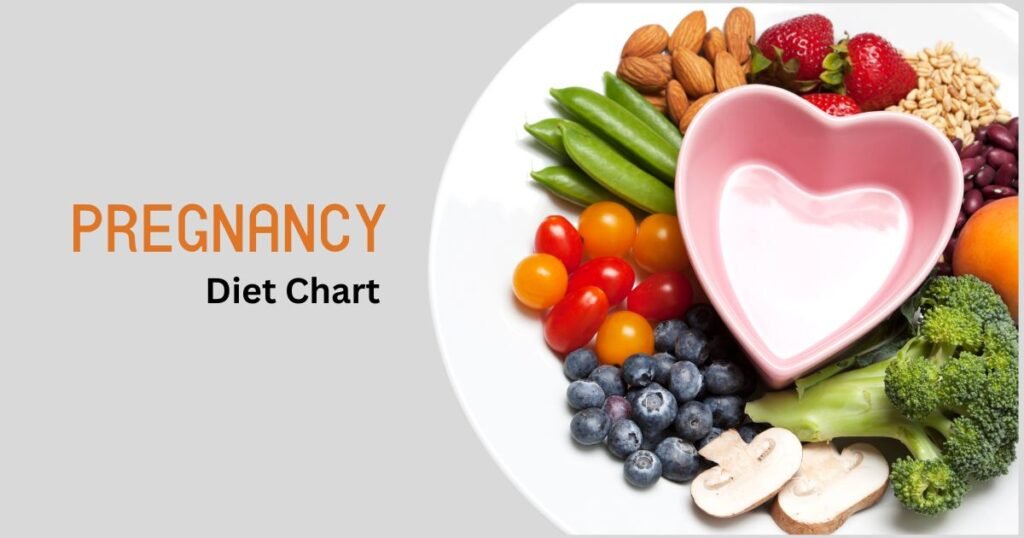Congratulations on your pregnancy journey! As you embark on this incredible adventure, it’s important to prioritize your health and well-being, not only for yourself but for your growing baby as well. One of the best ways to ensure a healthy pregnancy is by following a well-balanced diet.
In this article, we will guide you through a pregnancy diet chart, month by month, to help you make informed choices and nourish your body and baby every step of the way.

First Trimester (Months 1-3)
During the first trimester, the baby’s development is rapid, and the mother’s body undergoes significant changes. It’s essential to focus on nutrient-rich foods to support this growth while also managing common pregnancy symptoms such as nausea and fatigue.
Diet Chart:
- Whole grains: Opt for whole wheat bread, brown rice, oats, and quinoa to provide essential carbohydrates and fiber.
- Lean proteins: Include sources like lean meats, poultry, fish, tofu, and legumes to support muscle and tissue development.
- Dairy products: Consume low-fat milk, yogurt, and cheese for calcium and vitamin D.
- Fruits and vegetables: Aim for a variety of colorful options to obtain vitamins, minerals, and antioxidants.
- Healthy fats: Incorporate sources like avocados, nuts, seeds, and olive oil for brain development and hormonal balance.
What to Avoid:
- Raw or undercooked meats and seafood to prevent foodborne illnesses.
- High-mercury fish such as shark, swordfish, king mackerel, and tilefish, as they can harm fetal development.
- Excessive caffeine intake, as it may increase the risk of miscarriage.
Second Trimester (Months 4-6)
The second trimester is often considered the most comfortable period of pregnancy. As the baby continues to grow, the mother’s appetite may increase, necessitating a focus on nutrient-dense foods to support both their needs.
Diet Chart:
- Iron-rich foods: Incorporate sources like lean red meat, poultry, beans, lentils, and fortified cereals to prevent anemia.
- Calcium sources: Continue consuming dairy products or opt for fortified plant-based alternatives to support bone health.
- Omega-3 fatty acids: Include fatty fish like salmon, walnuts, and flaxseeds to promote the baby’s brain and eye development.
- Vitamin C-rich foods: Consume citrus fruits, bell peppers, and strawberries to aid in iron absorption.
- Fiber-rich foods: Maintain regular bowel movements by including fruits, vegetables, whole grains, and legumes.
What to Avoid:
- Soft cheeses, unpasteurized dairy products, and deli meats to minimize the risk of foodborne illnesses.
- Excessive intake of sweets and processed foods, which provide empty calories and may contribute to gestational diabetes.
Third Trimester (Months 7-9)
In the final trimester, the baby undergoes significant growth, and the mother may experience increased discomfort. Prioritizing nutrient-dense foods is crucial for both maternal health and optimal fetal development.
Diet Chart:
- Protein-rich foods: Continue consuming lean meats, eggs, tofu, and legumes to support fetal growth and maternal tissue repair.
- Magnesium sources: Include leafy greens, nuts, seeds, and whole grains to regulate blood sugar levels and prevent muscle cramps.
- Vitamin-rich foods: Consume plenty of fruits and vegetables to provide essential vitamins A, C, and K.
- Healthy snacks: Opt for nutritious snacks like Greek yogurt with berries, hummus with vegetables, or whole-grain crackers with cheese to maintain energy levels.
- Hydration: Drink plenty of water throughout the day to prevent dehydration and support amniotic fluid levels.
What to Avoid:
- Raw sprouts, as they may contain harmful bacteria.
- Excessive intake of large fish due to potential mercury contamination.
- Alcohol consumption, as it can lead to birth defects and developmental issues.
Conclusion: A well-balanced diet is essential for a healthy pregnancy and optimal fetal development. By following this month-by-month guide and incorporating nutrient-rich foods while avoiding potential hazards, expecting mothers can support their own health and ensure the best start for their growing baby. Always consult with a healthcare provider or a registered dietitian to tailor dietary recommendations to individual needs and preferences.
Pregnancy diet chart by trimester in table
Here is diet chart by pregnancy trimester. You can easily understand what type of diet should be beneficial for you during pregnancy and what food should avoid.
| Trimester | Months | Diet Chart | What to Avoid |
|---|---|---|---|
| First Trimester | 1-3 | – Whole grains: whole wheat bread, brown rice, oats, quinoa – Lean proteins: lean meats, poultry, fish, tofu, legumes – Dairy products: low-fat milk, yogurt, cheese – Fruits and vegetables: variety of colorful options – Healthy fats: avocados, nuts, seeds, olive oil | – Raw or undercooked meats and seafood – High-mercury fish (shark, swordfish, king mackerel, tilefish) – Excessive caffeine intake |
| Second Trimester | 4-6 | – Iron-rich foods: lean red meat, poultry, beans, lentils, fortified cereals – Calcium sources: dairy products, fortified plant-based alternatives – Omega-3 fatty acids: fatty fish, walnuts, flaxseeds – Vitamin C-rich foods: citrus fruits, bell peppers, strawberries – Fiber-rich foods: fruits, vegetables, whole grains, legumes | – Soft cheeses, unpasteurized dairy products, deli meats – Excessive intake of sweets and processed foods |
| Third Trimester | 7-9 | – Protein-rich foods: lean meats, eggs, tofu, legumes – Magnesium sources: leafy greens, nuts, seeds, whole grains – Vitamin-rich foods: fruits and vegetables – Healthy snacks: Greek yogurt with berries, hummus with vegetables, whole-grain crackers with cheese – Hydration: plenty of water throughout the day | – Raw sprouts – Excessive intake of large fish due to mercury – Alcohol consumption |
This table format presents the information in a clear and organized manner, making it easy to reference the diet chart and what to avoid for each trimester of pregnancy.
Pregnancy diet chart month by month in table
The table with information on diet and what to avoid for each month of pregnancy:
| Month | Diet Chart | What to Avoid |
|---|---|---|
| 1 | Whole grains: whole wheat bread, brown rice, oats, quinoa Lean proteins: lean meats, poultry, fish, tofu, legumes Dairy products: low-fat milk, yogurt, cheese Fruits and vegetables: variety of colorful options Healthy fats: avocados, nuts, seeds, olive oil | – Raw or undercooked meats and seafood – High-mercury fish (shark, swordfish, king mackerel, tilefish) – Excessive caffeine intake |
| 2 | Iron-rich foods: lean red meat, poultry, beans, lentils, fortified cereals Calcium sources: dairy products, fortified plant-based alternatives Omega-3 fatty acids: fatty fish, walnuts, flaxseeds Vitamin C-rich foods: citrus fruits, bell peppers, strawberries Fiber-rich foods: fruits, vegetables, whole grains, legumes | – Soft cheeses, unpasteurized dairy products, deli meats – Excessive intake of sweets and processed foods |
| 3 | Protein-rich foods: lean meats, eggs, tofu, legumes Magnesium sources: leafy greens, nuts, seeds, whole grains Vitamin-rich foods: fruits and vegetables Healthy snacks: Greek yogurt with berries, hummus with vegetables, whole-grain crackers with cheese Hydration: plenty of water throughout the day | – Raw sprouts – Excessive intake of large fish due to mercury – Alcohol consumption |
| 4 | Iron-rich foods: lean red meat, poultry, beans, lentils, fortified cereals Calcium sources: dairy products, fortified plant-based alternatives Omega-3 fatty acids: fatty fish, walnuts, flaxseeds Vitamin C-rich foods: citrus fruits, bell peppers, strawberries Fiber-rich foods: fruits, vegetables, whole grains, legumes | – Soft cheeses, unpasteurized dairy products, deli meats – Excessive intake of sweets and processed foods |
| 5 | Protein-rich foods: lean meats, eggs, tofu, legumes Magnesium sources: leafy greens, nuts, seeds, whole grains Vitamin-rich foods: fruits and vegetables Healthy snacks: Greek yogurt with berries, hummus with vegetables, whole-grain crackers with cheese Hydration: plenty of water throughout the day | – Raw sprouts – Excessive intake of large fish due to mercury – Alcohol consumption |
| 6 | Iron-rich foods: lean red meat, poultry, beans, lentils, fortified cereals Calcium sources: dairy products, fortified plant-based alternatives Omega-3 fatty acids: fatty fish, walnuts, flaxseeds Vitamin C-rich foods: citrus fruits, bell peppers, strawberries Fiber-rich foods: fruits, vegetables, whole grains, legumes | – Soft cheeses, unpasteurized dairy products, deli meats – Excessive intake of sweets and processed foods |
| 7 | Protein-rich foods: lean meats, eggs, tofu, legumes Magnesium sources: leafy greens, nuts, seeds, whole grains Vitamin-rich foods: fruits and vegetables Healthy snacks: Greek yogurt with berries, hummus with vegetables, whole-grain crackers with cheese Hydration: plenty of water throughout the day | – Raw sprouts – Excessive intake of large fish due to mercury – Alcohol consumption |
| 8 | Iron-rich foods: lean red meat, poultry, beans, lentils, fortified cereals Calcium sources: dairy products, fortified plant-based alternatives Omega-3 fatty acids: fatty fish, walnuts, flaxseeds Vitamin C-rich foods: citrus fruits, bell peppers, strawberries Fiber-rich foods: fruits, vegetables, whole grains, legumes | – Raw sprouts – Excessive intake of large fish due to mercury – Alcohol consumption |
| 9 | Protein-rich foods: lean meats, eggs, tofu, legumes Magnesium sources: leafy greens, nuts, seeds, whole grains Vitamin-rich foods: fruits and vegetables Healthy snacks: Greek yogurt with berries, hummus with vegetables, whole-grain crackers with cheese Hydration: plenty of water throughout the day | – Raw sprouts – Excessive intake of large fish due to mercury – Alcohol consumption |
This table now provides pregnant mothers with a comprehensive guide, including both dietary recommendations and what to avoid for each month of pregnancy.
Frequently asked question
What should I eat during the first month of pregnancy?
During the first month of pregnancy, it is important to focus on eating a well-balanced diet that includes plenty of fruits, vegetables, whole grains, and lean protein. It is also important to stay hydrated and avoid foods that are high in sugar and unhealthy fats.
Should I take any supplements during the second month of pregnancy?
During the second month of pregnancy, it is recommended to start taking a prenatal vitamin that includes folic acid, iron, and calcium. These nutrients are important for the healthy development of your baby.
How can I combat nausea during the third month of pregnancy?
During the third month of pregnancy, many women experience morning sickness and nausea. To combat these symptoms, it is important to eat small, frequent meals throughout the day and avoid foods that trigger nausea. Ginger and peppermint can also help alleviate symptoms of nausea.
What should I focus on eating during the fourth month of pregnancy?
During the fourth month of pregnancy, it is important to focus on eating nutrient-dense foods that are rich in vitamins and minerals. This includes foods like leafy greens, fortified cereals, and lean protein sources.
How can I prevent constipation during the fifth month of pregnancy?
During the fifth month of pregnancy, many women experience constipation due to hormonal changes and pressure on the digestive system. To prevent constipation, it is important to drink plenty of water, eat high-fiber foods like fruits and vegetables, and engage in regular physical activity.
Are there any foods I should avoid during the sixth month of pregnancy?
During the sixth month of pregnancy, it is important to avoid foods that may be contaminated with harmful bacteria, such as raw seafood, unpasteurized dairy products, and deli meats. It is also important to limit your intake of caffeine and avoid alcohol completely.
How can I maintain a healthy weight during the seventh month of pregnancy?
During the seventh month of pregnancy, it is important to focus on eating nutrient-dense foods and engaging in regular physical activity to maintain a healthy weight. It is also important to listen to your body’s hunger cues and avoid overeating.
Are there any specific foods that can help with fetal development during the eighth month of pregnancy?
During the eighth month of pregnancy, it is important to focus on eating foods that are rich in omega-3 fatty acids, such as salmon, walnuts, and flaxseeds. These nutrients are important for the healthy development of your baby’s brain and nervous system.
How can I prevent heartburn during the ninth month of pregnancy?
During the ninth month of pregnancy, many women experience heartburn due to the pressure of the growing uterus on the stomach. To prevent heartburn, it is important to eat small, frequent meals, avoid spicy and acidic foods, and avoid lying down immediately after eating.
What should I focus on eating during the tenth month of pregnancy?
During the tenth month of pregnancy, it is important to focus on eating foods that are high in iron and vitamin C to support healthy blood production and absorption. Foods like lean red meat, beans, and citrus fruits can help meet these nutrient needs.







